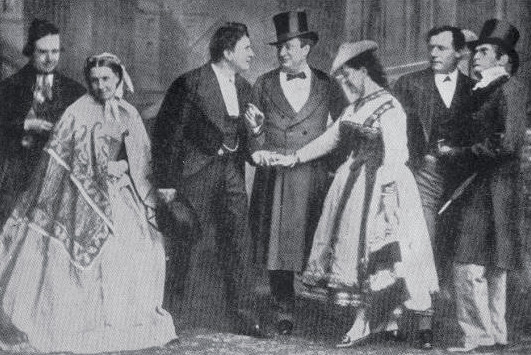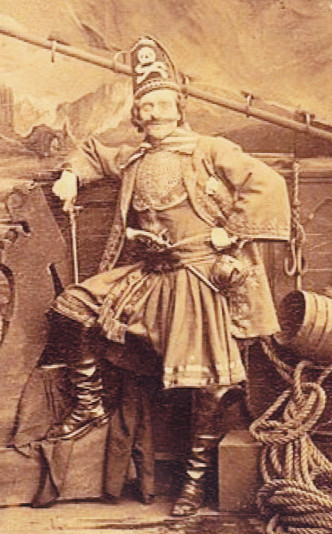1869
- For Miss Henrietta Hodson, a benefit performance at the Queen’s Theatre, at Covent Garden, London.
- The Dead Heart, at The Royal Adelphi Theatre.
- No Thoroughfare, at Victoria Theatre, Waterloo, London.
- A benefit performance at The Surrey Theatre, in Lambeth, with Henry Irving, in July. Irving was 31 years of age and had been on stage for 13 years, however he had been struggling as an actor and had not yet had a breakout success at this time. He married Florence O’Callaghan, his only wife, just a few days after this.
- The Cedars, a benefit performance for West London Hospital, on Edgware Road.
- The Willow Corpse, at The Royal Adelphi Theatre.
- The Greenwich Pensioner, at The Royal Adelphi Theatre and at Theatre Royal in Portsmouth. This performance was credited as being put on by The George Belmore Company.
- The Deal Boatman, at Theatre Royal in Portsmouth. This performance was credited as being put on by The George Belmore Company.
- The Flying Scud, at Theatre Royal in Portsmouth.
- Black and White, at the Royal Adelphi Theatre, London.
- Domestic Economy, at the Royal Adelphi Theatre, London.
- The Long Strike, at the Royal Adelphi Theatre, London.

- Paul Belmore Garstin was born to George and Alice on the 12th of May. Like all his siblings he took up acting, and toured around the world including Australia and America. He married Bessie Rignold, an actress. Sadly he died young at 36 in 1907, while on stage, during a performance of the play Leah Kleschna.
- Civilisation, at Sadlers Wells Theatre Royal.
- Self Made, at The Princess’s Theatre.
- Remy, at The Princess’s Theatre.
- A Dark Nights Work, at The Princess’s Theatre.
- Box and Cox, at The Gaiety Theatre, Aldwych, London.
- Little Em’ly, at The Royal Olympic Theatre, near Drury Lane. Little Em’ly is based on a part of Charles Dickens’ eighth novel David Copperfield.
- Mary Warner, at The Gaiety Theatre.
- The Varsity Boat Race, at The Gaiety Theatre.
- Little Em’ly, at The Gaiety Theatre.
George Belmore then stayed at The Royal Olympic Theatre in London for several shows. This theatre was later demolished to create The Aldwych, a road in London, in 1889.
- Little Em’ly.
- Udine.
- The Varsity Boat Race.
- Handsome Is that Handsome Does.
- Poppleton’s Predicament.
- Flying Sand, a benefit for George Belmore.
- Paul and Virginia.
- Flying Scud, a benefit for George Belmore.
- Old Curiosity Shop.
- Nell.
- A benefit for Mr. Cave, the manager of Victoria Theatre.

1871
- Old Curiosity Shop.
- Nell.
- A benefit for Mr. J. Clark.
- Daisy Farm. A press article said of this “The acting of Mr. G. Belmore as a generous-hearted Derbyshire farmer is exceedingly good, and his homely pathos is most artistically portrayed. Indeed, Mr. Belmore is to be always recognised as one of the very few performers known on the English boards who are fairly entitled to be called artists”.
- Giselle.
- Farewell Benefit for George Belmore, on the 25th of August.
George Belmore joined The Henry Irving Company, and is on stage with Henry Irving on the 11th of September 1871 for the opening of their new season of performances.
The following shows were all at the Royal Lyceum Theatre, at 21 Wellington Street, Strand, Westminster, with Henry Irving’s Company:
- Fanchette, the Will o’-the-Wisp. A new play adapted from George Sand’s ‘La Petite Fadette’.
- De Grille.
- Hear at Law.
- Pickwick.
- Flying Scud and My Turn Next.
- George and his wife Alice had their fifth child, Lillian Belmore Garstin. She went into acting also, but died young after cancelling a stage performance in London, in 1901.
- The Haunted Crust, at the Royal Lyceum Theatre.
- Little Em’ly, at London National Theatre.
- Leah, at Royal Lyceum Theatre.
- Charles I, at Royal Lyceum Theatre, with Henry Irving’s Company.
- The Flying Scud or My Turn Next at The Theatre Royal in Leeds, followed by the Gaiety Theatre in Dublin, Ireland, with The George Belmore Company.
- The Son of the Night, at Sadlers Wells Theatre Royal, London.
- Benefit Performance for Mr. James Guives, at Royal Princess’s Theatre, London.
- The Boarding School, at Sadlers Wells Theatre Royal.
- Charles I, at Royal Lyceum Theatre. This started in September and ran for 180 performances, into April 1873.
1873
- My Turn Next, at Royal Lyceum Theatre.
- Charles I, at Royal Lyceum Theatre.
- Dadletton’s Difficulties, at Royal Lyceum Theatre.
- Media and My Turn Next, at Royal Lyceum Theatre.
- All that Glitters is not Gold, at Marylebone Theatre Royal.
- My Turn Next, at North Woolwich Gardens in east London.
- A Widow Hunt, at the Theatre Royal, Haymarket.
- Aurora Floyd, at Marylebone Theatre Royal.
- The King of the Scots, at Marylebone Theatre Royal. George played King James, and did five farewell performances. This was the last time George appeared at this theatre. He was soon to depart for New York.
- The Lottery Ticket, at London National Theatre. George and his wife Alice appeared together.
- Fanchette, at Theatre Royal, Drury Lane.
In October 1873, a farewell lunch was given to George in anticipation of his leaving for America, attended by friends and colleagues in the theatre industry. He received much praise for his mastery of acting. George gave a speech about a close friend of his called William Cave, who had died, and then went on to detail his intentions for the US. Several toasts were given and a gold ring was presented to George. However, he didn’t set sail just yet.
